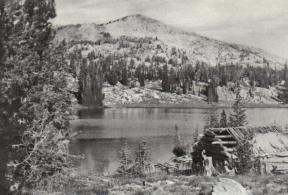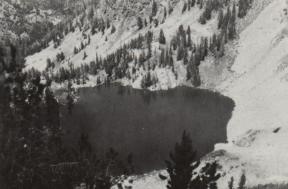The Buffalo Hump

Buffalo Lake and Buffalo Hump
|
Buffalo Hump, the most prominent of the peaks of the Clearwater Mountains, rises in the center of a triagle formed by the three mining towns of Warren, Elk City and Florence, mining camps which in the 1860's produced something over $100,000,000 in placer gold. This high mountain peak can be seen to the southeast of St. Gertrude's Convent, snowcapped much of the year. Buffalo Hump takes its name from a prominent intrusive into the Idaho granite batholith rising to an elevation of 8,926 feet in the form of a recumbent buffalo and is a prominent landmark of the central Idaho region Speaking of the gold discoveries in Idaho during the early 1860's, James H. Hawley stated: Of the thousands who came into the new camp of Florence during the summer of 1862, nearly all stopped for a short time at least. The limited area of place ground, however, in that vicinity, soon became apparent and prospecting parties started in all directions. As usual in all mining camps the unfounded reports of rich discvoeries soon became circulated among those remaining in the camp, and it was early in the summer of 1862 that a rumor became current there that rich mines had been discvoered at the base of the mountain known as Buffalo Hump, a well known mountain, situated about forty miles northeast of Florence, and to the new El Dorado went practically all of those who had come into the new section; they packed their scant amount of provisions and blankets on their backs and started for the new El Dorado, but only disappointments awaited them there, as they soon ascertained. There was no placer gold and the gold-bearing ledges cropping out in many places were of a low grade and could not be profitably worked at that time. ("History of Idaho, Vol. I, 1920) Some years later, Buffalo Hump mines began to prosper in 1898 From "Illustrated History of North Idaho," quoting a man named Attorney Nash: No one had any idea of the enthusiasm that the Buffalo Hump strike has arroused. It is all and even more than the locators claimed for it. The assays run to phenomenal values and none of the returns have been low. The strike itself is one of the most phenomenal geological freaks ever discovered. It consists of a huge vein of ore thrown up on the face of the plain and for five miles one can ride along beside it on horseback. In its course the vein runs straight through the Salmon River. For two weeks past men have been flocking from all directions to the camp. At night the camp fires resemble those of an army; for miles around they leap heavenward. More than two hundred prospectors were living in tents along the vein when I left Grangeville. Florence and the other camps are almost depopulated; men threw up good jobs to get to the strike; you meet them on foot, huge packs on their backs; on horseback, two men on a horse . . . all with but one thought -- to stake out a claim before all are gone. For years trained and veteran prospectors camped beside it, and climbed over and around to get into the renowned diggings in Boise Basin, in the Florence district, in the northern counties, into the Seven Devils country and to dozens of other localities long since forgotten.
|
